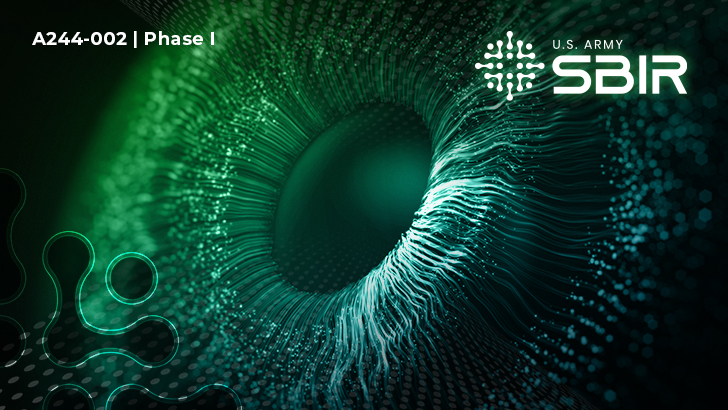

Selectees
Objective
Small and nontraditional businesses must develop precision contact lens, eye tracking sensors for Extended Reality (XR) interaction, training optimization and cognitive monitoring. Eye tracking is poised to serve as a critical technology for enhancing Command and Control (C2) capabilities in XR environments, and it could optimize training and cognitive monitoring in real-time adaptive systems.
However, current eye tracking technologies do not have form factors that can operate in rugged, highly mobile army environments. They also do not have the precision to enable necessary capabilities. A contact lens form factor could integrate into several wartime dynamic scenarios for joint-mission precision, including manned and unmanned air operations and ground vehicle systems.
Description
Camera-based eye tracking technology lacks precision, manufacturability and sustainment for high tempo and mobile operations. Current high-precision eye trackers require minimal changes in head position, pupil size and ambient lighting for valid data — and only enable static operational scenarios.
Contact lens-based eye tracking can measure movement of the eye itself, avoiding complex and noisy image processing algorithms that traditional high-precision eye tracking systems rely on. The technology also has a form factor that is acceptable for mission demands.
Ground Vehicle System Center (GVSC) has a concept for using the contact lens in mounted individuals as a controller in a multilayered XR User Interface (UI) for Head-Mounted Displays (HMDs). Instead of using a physical controller or gesture recognition, the eyes can serve to select virtual objects in the environment.
Here, soldiers would not rely on traditional physical buttons or controllers to interact and could rely on their eyes, increasing the speed and intuitive nature of interacting with head-mounted display (HMD) interfaces.
Phase I
Small and nontraditional businesses are required to provide feasibility studies for an eye-tracking system with sensors embedded in the contact lens.
Phase II
Small and nontraditional businesses must have working testbed prototypes and sensors that can collect binocular eye-gaze position, pupil size and blinks. They must also show comparisons versus gold standard, high-precision eye trackers.
Phase II Sequential: Firms must provide human-factor feasibility studies through soldier touchpoints.
Phase III
Submission Information:
All eligible small businesses must submit proposals by 12:00 PM, Eastern Time.
To view full solicitation details, click here.
For more information, and to submit your full proposal package, visit the DSIP Portal.

References:
Selectees
Objective
Small and nontraditional businesses must develop precision contact lens, eye tracking sensors for Extended Reality (XR) interaction, training optimization and cognitive monitoring. Eye tracking is poised to serve as a critical technology for enhancing Command and Control (C2) capabilities in XR environments, and it could optimize training and cognitive monitoring in real-time adaptive systems.
However, current eye tracking technologies do not have form factors that can operate in rugged, highly mobile army environments. They also do not have the precision to enable necessary capabilities. A contact lens form factor could integrate into several wartime dynamic scenarios for joint-mission precision, including manned and unmanned air operations and ground vehicle systems.
Description
Camera-based eye tracking technology lacks precision, manufacturability and sustainment for high tempo and mobile operations. Current high-precision eye trackers require minimal changes in head position, pupil size and ambient lighting for valid data — and only enable static operational scenarios.
Contact lens-based eye tracking can measure movement of the eye itself, avoiding complex and noisy image processing algorithms that traditional high-precision eye tracking systems rely on. The technology also has a form factor that is acceptable for mission demands.
Ground Vehicle System Center (GVSC) has a concept for using the contact lens in mounted individuals as a controller in a multilayered XR User Interface (UI) for Head-Mounted Displays (HMDs). Instead of using a physical controller or gesture recognition, the eyes can serve to select virtual objects in the environment.
Here, soldiers would not rely on traditional physical buttons or controllers to interact and could rely on their eyes, increasing the speed and intuitive nature of interacting with head-mounted display (HMD) interfaces.
Phase I
Small and nontraditional businesses are required to provide feasibility studies for an eye-tracking system with sensors embedded in the contact lens.
Phase II
Small and nontraditional businesses must have working testbed prototypes and sensors that can collect binocular eye-gaze position, pupil size and blinks. They must also show comparisons versus gold standard, high-precision eye trackers.
Phase II Sequential: Firms must provide human-factor feasibility studies through soldier touchpoints.
Phase III
Submission Information:
All eligible small businesses must submit proposals by 12:00 PM, Eastern Time.
To view full solicitation details, click here.
For more information, and to submit your full proposal package, visit the DSIP Portal.
References:
